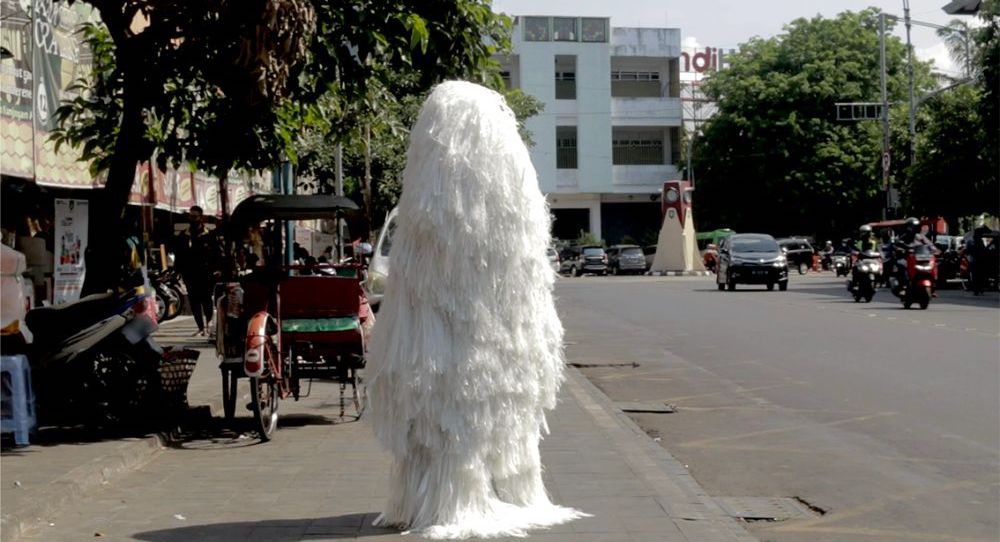She summarises it thus, “Probably, when you see my dance, it is not like a choreography you would normally understand, nor is it following the rules of making choreography.”
Speaking from her home in Solo, Indonesia, Melati Suryodarmo is keen for us to understand that she does not create in a bubble. Having trained in Butoh with Anzu Furukawa and in performance art with Marina Abramovic, she has evolved a multi-sided practise that weaves dance, video and visual art into works that are often durational and laced with elements of endurance and absurdity.
When she brings her new work, Lapse, to Asia TOPA in March, she will also be inviting Australian audiences into a world of curated chaos. “No matter how much you want to resist,” she argues, “if the majority is a kind of a chaos, then you are part of this disorder.”
Here, she channels the ubiquitous declinism of the times, tapping into the shared angst of a world uncomfortable in its current skin. Yet, refreshingly, she is not about to serve us another dollop of dystopia. Suryodarmo’s lens is calibrated for finer textures.
As she explains, “When I work, I’m very much into observing rather than claiming the issue. From my humble position in society, I try to observe as much as possible. I go to the street of everyday life, just like an ordinary person; and I don’t have a car, so I prefer to walk…and I see the majority situation in a direct way. I try to sense whatever is happening in society. This is how I like to begin my research. You know, how has history carried us into this situation?”
Born in 1969, she grew up under the Suharto dictatorship. After a period of student activism in the ’80s, she moved to Germany in 1994, where she remained for nearly 20 years before returning to Java. In addition, she has worked around the world, and even scored a YouTube viral hit with her now famed Butter Dance. Net result, personal history has broadened her perspective on global history. Thus, the turbulence she alludes to in Lapse is coloured with her experiences of post-colonialism, authoritarianism, democratisation and rapid modernisation.
“In Lapse, I focus on this changing, and how people actually agree,” she notes. “They make a common agreement somehow. So, in Indonesia, we are not used to democracy; so we might question why or how democracy is being introduced, or enforced. It’s not part of our history, so it’s very tough.”
Now in her mid-50s, Suryodarmo is better able to draw back from the magnifying effects of presentist drama. “I return to the idea of the language of knowledge, which is sometimes through mythology, through our relationship with nature, and through our togetherness, our collective being as a society.”
However, the complexities of inspiration invariably seek more distilled forms in art. As Suryodarmo says, “A lot of my work is very political, but the choreography is more engaging with the story of a long history of an embodied culture. It’s about reality; but not reality, per se, more what is behind the soul of the body.”
Over the years, she has preferred repetitive movement, often seeking to break down the orthodoxies of story arc, choreography and spectating. With Lapse, however, she is staying closer to home. “This choreography is not something exotic or distant from our modern life,” she reveals. “So, how is it that, through dance, the soul of the majority can appear?”
Deeper still, she suggests that Lapse, like many of her previous works, hints at something fundamental. “One of the most common beliefs of society is that we will take care of one another. This perhaps is the meaning of living together.”
Therefore, in a climate of chaos, what does it mean to care?
Again, as an artist, this poses further questions, most notably around the translation of intention into production? Suryodarmo’s stated modus operandi is to mould her work to be “performed everywhere.” Her focus, she insists, is on “creating a space rather than occupying a space.”
What this means for the performers is that “they have to be themselves.” As Suryodarmo observes, “They know who they are. They are not a machine that I pay. So, I always work with dancers that I know personally.”
She laughs wryly as she says this, quickly adding, “It’s not easy for them. It’s not 3, 4, 5, 6, follow this movement. It’s about reducing ego. Why? Because when we reduce the ego, we give more space for the audience.”
In this, we hear something of Suryodarmo’s Buddhist philosophy, which in turn folds back into the advertised themes of Lapse. If indeed we currently live in a sea of viral tumult and anxious uncertainty, how can we best respond?
Pausing for a beat, she tries again to encapsulate not only the work in question but the essence of choreography. “It’s about the potential of becoming chaos, of becoming pure energy. Because we can never really calculate how people will move.”
Melati Suryodarmo’s Lapse will be presented as part of Asia TOPA from 6 – 8 March. For tickets and more information, visit www.asiatopa.com.au/event/lapse.
By Paul Ransom of Dance Informa.

















